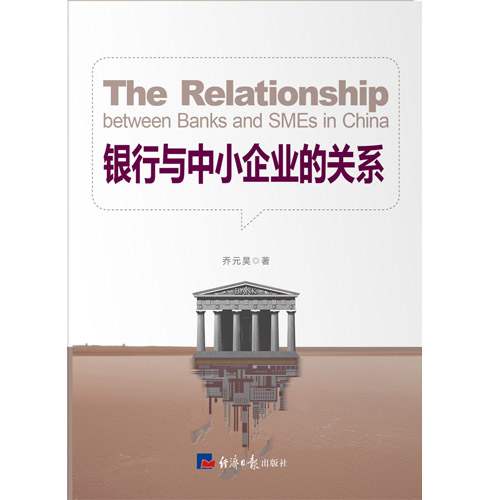《銀行與中小企業的關係》是2016年7月經濟日報出版社出版的圖書,作者是喬元昊。
基本介紹
- 書名:銀行與中小企業的關係
- 作者:喬元昊
- ISBN:9787802579552
- 定價:58
- 出版社:經濟日報出版社
- 出版時間:2016年7月
內容簡介
目錄
序言二(蔣小明)
ABSTRACT
ACKNOWLEDGEMENTS
CONTENTS
LIST OF TABLES
LIST OF FIGURES
LIST OF ABBREVIATIONS
DECLARATION
Chapter One—Introduction to the Thesis
1.1.Introduction
1.2.Understanding SMEs in China
1.3.Central government policy in China and how it influences SME lending
1.4.Research aim
1.5.Research objectives
1.6.The approach to the study
1.7.Methodology
1.8.Structure of the thesis
Chapter Two—Research Background and Literature Review
2.1.Introduction
2.2.Research Background
2.2.1.The development of the SME sector in China
2.2.2.The development of the banking sector in China
2.2.3.The relationship between the banks and SMEs during 1978—2012
2.3.Literature Review
2.3.1.Relationship Marketing
2.3.2.Relationship banking
2.3.3.SME—Bank relationships
2.3.4.Social indicators which could be used to evaluate SMEs and SME owners
2.3.5.Credit evaluation systems in the West and in China
2.4.The reasons for the difficulties which SMEs experience in obtaining loans
2.4.1.Obstacles to bank lending to SMEs
2.4.2.An analysis of the obstacles
2.5.Summary
Chapter Three—Qualitative Methodology and Interview Design
3.1.Introduction
3.2.The research methodology—a mixed methodology
3.3.Rationale for qualitative research
3.4.The data collection approaches and process
3.5.The Sample and Questions for the interviews with the bank managers
3.6.Two pilot interviews with lending bankers
3.6.1.Profile of the two participants in the pilot interviews
3.6.2.Key points gathered from the pilot interviews
3.6.3.Revision of the interview structures
3.7.The execution phase of the interviews
3.8.Summary
Chapter Four—Analysis of the Interviews
4.1.Introduction
4.2.Key areas of the research
4.3.Ov erview of the theory
4.4.Profile of the 10 interviews
4.4.1.Coding of participants
4.4.2.Recording and transcription
4.4.3.Color coding of paragraphs
4.5.Overview of the interviews with the 10 bank managers
4.5.1.Banking structures established to manage SME loans
4.5.2.Overview of the lending strategies of the six banks
4.5.3.Customized lending products offered by the banks
4.5.4.The evaluation process
4.6.Seeking target clients from networks—criteria developed from the "Social Capital" identified by the 10 bank managers (1)
4.6.1.Introduction
4.6.2.Network 1—The business circle:
4.6.3.Network 2—The industry association:
4.6.4.Network 3—Supply chain
4.6.5.Network 4—Local people living in the same village community
4.6.6.Network 5—Migrant groups
4.6.7.Network 6—SME owners who are long—term clients of the bank
4.6.8.Network 7—New clients introduced by existing clients of the bank
4.6.9.Network 8—The banks provide a platform
4.6.10.Discussion
4.7.Visiting SMEs' plants and offices—criteria developed from the "Social capital" identified by the 10 bank managers (2)
4.7.1.Factors considered by lending bankers during the on—site visit
4.7.2 .Discussion
4.8.Conduct a financial investigation—"Economic indicators" provided by the 10 bank managers, on which the banks focus their attention
4.8.1.The SME's "Current account"
4.8.2.The bills or receipts provided by third parties
4.8.3.The intended use of the loan
4.8.4.The collateral being provided by the SME
4.8.5.Continuous profitability
4.8.6.Discussion
4.8.7.Summary
4.9.Interview with the SME owner—criteria developed from the "human capital" identified by the 10 bank managers (1)
4.9.1.Factors considered by the lending bankers
4.9.2 .Discussion
4.10.Investigation of the SME owner's reputation through his/her part ners and/or related persons—criteria developed from the "human capi tal" issues identified by the 10 bank managers(2)
4.10.1.Factors considered by the lending bankers in the investigation of the owner's reputation
4.10.2 .Discussion
4.11.The lending decision—making process
4.12.Towards a theoretical model of factors infiuencing loan decisions in SME—Bank relations
4.12.1 .Introduction
4.12.2.Overview of Model 1
4.12.3.Characteristics of Model 2
4.12.4.Explanation of Model 2
4.12.5.The relationship between Model 2 and the literature
4.13.Findings which emerged from the interviews with the 10 bank managers
4.13.1.Important factors identified from the interviews
4.14.Summary
……
Chapter Five—Quantitative methodology and questionnaire design
Chapter Six—Analysis of Questionnaire Survey
Chapter Seven—Research outcomes and implications
LIST OF REFERENCES
Appendix 1:The definition Of SMES
Appendix 2:Preparation for interviews
Appendix 3:Introduction to 10 bank managers
Appendix 4:Questionnaire Questions
Appendix 5:回顧中國政府對銀行的放權進程

